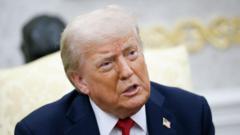Amid the political and economic tensions between the United States and China, the latest reports indicate that China's economy is exhibiting resilience, growing at a pace that suggests continuity in expansion.
China's Economic Growth Defies Tariffs Amid Strategic Investments

China's Economic Growth Defies Tariffs Amid Strategic Investments
Despite the impact of U.S. tariffs, China reports steady economic growth bolstered by strategic investments and increased global exports.
China’s economy has shown remarkable growth this spring, posting official figures that reflect a steadiness despite the challenges posed by steep tariffs enacted by the Trump administration. The country’s resilience is attributed to significant investments in factories and major infrastructure projects, such as high-speed rail developments. Additionally, anticipating these tariffs, there was a surge in orders during the first quarter of the year, which contributed to stimulating the economy further.
If this trajectory of economic growth persists, China’s annual growth rate could hover around 4.1 percent, presenting a slight slowing compared to the previous quarter's performance. This contrast in growth comes at a time when the United States grapples with rising inflation, in part due to the tariffs, which have driven prices upward, particularly in sectors like household furnishings.
In an unexpected policy shift, the U.S. government recently reversed its ban on Nvidia's chip sales to China, allowing Chinese tech firms to resume acquiring these crucial products. This decision comes just three months post the initial prohibition.
On the electric vehicle front, Beijing has announced restrictions against transferring eight essential technologies necessary for battery manufacturing outside of China. This could potentially complicate endeavors for Chinese electric vehicle manufacturers aiming to establish production facilities overseas, especially with the European Union pressing them to expand their operations.
In diplomatic relations, Australian Prime Minister Anthony Albanese engaged in talks with China’s leader Xi Jinping, advocating for strengthened ties amid pressures from the U.S. to maintain a firmer stance against Beijing.
In light of these developments, the global economic landscape continues to evolve, reflecting the interplay of international trade policies and domestic investments that shape the dynamics between the world's foremost economies.
If this trajectory of economic growth persists, China’s annual growth rate could hover around 4.1 percent, presenting a slight slowing compared to the previous quarter's performance. This contrast in growth comes at a time when the United States grapples with rising inflation, in part due to the tariffs, which have driven prices upward, particularly in sectors like household furnishings.
In an unexpected policy shift, the U.S. government recently reversed its ban on Nvidia's chip sales to China, allowing Chinese tech firms to resume acquiring these crucial products. This decision comes just three months post the initial prohibition.
On the electric vehicle front, Beijing has announced restrictions against transferring eight essential technologies necessary for battery manufacturing outside of China. This could potentially complicate endeavors for Chinese electric vehicle manufacturers aiming to establish production facilities overseas, especially with the European Union pressing them to expand their operations.
In diplomatic relations, Australian Prime Minister Anthony Albanese engaged in talks with China’s leader Xi Jinping, advocating for strengthened ties amid pressures from the U.S. to maintain a firmer stance against Beijing.
In light of these developments, the global economic landscape continues to evolve, reflecting the interplay of international trade policies and domestic investments that shape the dynamics between the world's foremost economies.




















